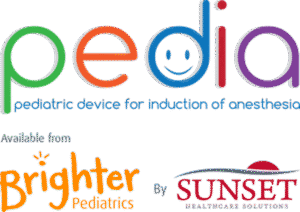Pediatric Anxiety During Induction of Anesthesia

It’s Time For A Change
In the 21st century, science and technology have launched medicine into territories once relegated to the areas of science fiction. Robotic assisted surgery and computer-aided navigation have granted vision and precision in the surgical field just as ultrasound imaging guidance has done for anesthesia. The video laryngoscope, like CoPilotVL, proved itself invaluable for difficult intubation and is on the fast-track to becoming a standard of care. Nonetheless, while some areas of anesthetic care have brightened, others remain in the dark ages.
Pediatric induction, for example, has remained unchanged since the early 20th century. But as the old adage goes: if it isn’t broken, don’t fix it. A standard mask induction works well enough and it’s easy: lay the child on the operating room table, place the anesthesia mask over his nose and mouth, turn on the oxygen-gas admixture, then watch as he gently drifts off to sleep. No needles. Simple. But easy? Well, not so fast.
Why Change Now?
Pediatric induction can be one of the most difficult techniques to master as well as the most stressful moment for a child undergoing surgery. More than 50% of children experience anxiety during the process. Crying, kicking, hitting and other forms of physical and verbal resistance to the noxious gasses often necessitate the need for physical restraint of the child, euphemistically referred to as brutane. A list of predictors for “noncompliant children” include younger age and shy temperament, but any child can decompensate once the anesthesia mask is placed. No amount of bubble gum flavoring can disguise the scent of Sevoflurane and, as far as distraction, there aren’t enough princess stickers, sing-along songs or videos to win over an inconsolable child.
That’s not to say all children react in this manner, but a high proportion are upset by the process of induction. Younger children suffer acute distress while children of all ages show signs of anticipatory distress. Children in need of frequent visits to the operating room (OR) experience even higher degrees of anxiety. The negative memory encodes with repeated exposure leading to exaggerated negative behaviors. Small cues, like the site of the anesthesia mask, elicit large consequences.
There's no fooling a veteran of the operating room, even if she's only four years old.
The effects of this bad experience last long after the moments it takes the child to fall asleep. When a child suffers anxiety at induction, she often develops a greater degree of postoperative emergence delirium. In the post-anesthesia recovery unit (PACU), these children exhibit crying fits and increased levels of pain. And it doesn’t end there. Post-discharge, parents report negative behaviors such as regression, bedwetting, nightmares, separation anxiety, temper tantrums and distrust of medical personnel. These stress-effects typically last two weeks for most children with some extending six months and, on rare occasions, a year.
Parents are also affected by the stress of induction. With the growing popularity of family-centered care, parental presence in the operating room during induction has morphed from a privilege to a standard. But contrary to popular belief, parental presence in the OR does not necessarily alleviate the child’s anxiety nor their own. Parents exhibit clinically significant signs of distress and those feelings can transfer from parent to child. Mom or dad sit on the sidelines, ever-watchful yet helpless as the child struggles against the anesthesia mask and well-meaning OR staff. The parent is told repeatedly the crying is “normal”, the process, “standard”. But does standard have to be accepted?
Alleviating Intraoperative Anxiety
To alleviate the intraoperative anxiety and negative postoperative behavior, a plethora of pharmacological modalities have been tried but with mixed success. At one time, midazolam was touted as the magic bullet. But the bullet missed the mark. In some children, oral midazolam causes a paradoxical effect. Instead of sedation, it elicits agitation, aggression, restlessness and self-injury making a bad situation worse.
Midazolam is also avoided as a routine order for more pragmatic reasons. Timing of this oral benzodiazepine makes it’s use difficult in the setting of a busy OR. Also, cooperation by the child is imperative. And an anxious child may refuse to drink it. Finally, in these days of shrinking medical dollars, oral sedation preoperatively may delay emergence from anesthesia and postoperative discharge thereby increasing operating costs.
On the other end of the spectrum, some nonpharmacological approaches have been shown to reduce perioperative stress. The use of presurgical educational pamphlets, preoperative visits, play therapy, music therapy and even doctors dressed as clowns have been shown to attenuate anxiety. Distraction is the key. Today, with the ever-increasing accessibility of tablets, cell phones and YouTube, distraction is only an app away. An internet search quickly retrieves a favorite cartoon, song, or video game making the ride back to the OR pleasant if not carefree.
However, as a child crosses the threshold into the cold and austere world called the operating room (with its intimidating machines, clanking medical instruments, and strangers), the electronics go down and the anxiety goes up. Once the child realizes the “pilot’s mask” doesn’t smell like bubblegum, playtime is over.
Or is it?
Why not continue the play in the operating room? Why not dedicate specific rooms for pediatrics? Have cartoon characters on the wall? Bright colors? Familiar music in the background?
Change is necessary but a change in operating room protocol and mindset is even more important than aesthetics. Once the child and parent enter the OR, full attention should turn to them: no counting of instruments and OR-talk. The child is the most important person in the room, so treat them with respect and dignity. Maintain eye contact. Speak to her. Give him choices whenever possible. Ask, “Would you like to sit up on the table or on mom’s (or dad’s) lap? Which finger do you want the finger-sticker on? Do you want to hold the mask?”
Then prepare for induction. Once the anesthesia circuit is primed with nitrous, allow the child to assist you if she chooses. Have her hold the mask to her face. If she resists, gently hold her hands at her side while your sing a song. Then slowly dial up the anesthetic gas.
Alternatively, try an anesthesia induction device. A number of mask-base distraction devices have been created over the years and one mask-free device is now under investigation. Mask-free? Why not? If science and technology can build a better robot to improve surgical outcomes, it can build a better device to improve induction.
In closing, it’s time to address this unfulfilled need. We must update the process of pediatric induction, bring it out of the dark ages and into the 21st century. New methods, innovative devices, and and endless list of intraoperative play are needed to relieve anxiety, avoid negative postoperative behavior changes and engender trust in the medical personnel. The operating room can and should be nurturing, comforting and fun. After all, the patient, parent and even practitioner deserve a positive experience.
Utilizing A Mask-Free Induction System
Instead of the scary, claustrophobic-feeling, foul-smelling anesthesia mask and dozens of distraction techniques that don’t work because they STILL use a mask, try PEDIA! The Pediatric Device for Induction of Anesthesia, Pedia Anesthesia Balloons, are the world’s first MASK-FREE anesthesia gas delivery system designed just for kids. The colorful balloons and whistling sounds of this anesthesia “toy” distracts, engages and engenders cooperation. Try it today. Visit PediaLLC.com or email moc.c1767398936llaid1767398936ep@tc1767398936atnoc1767398936.




